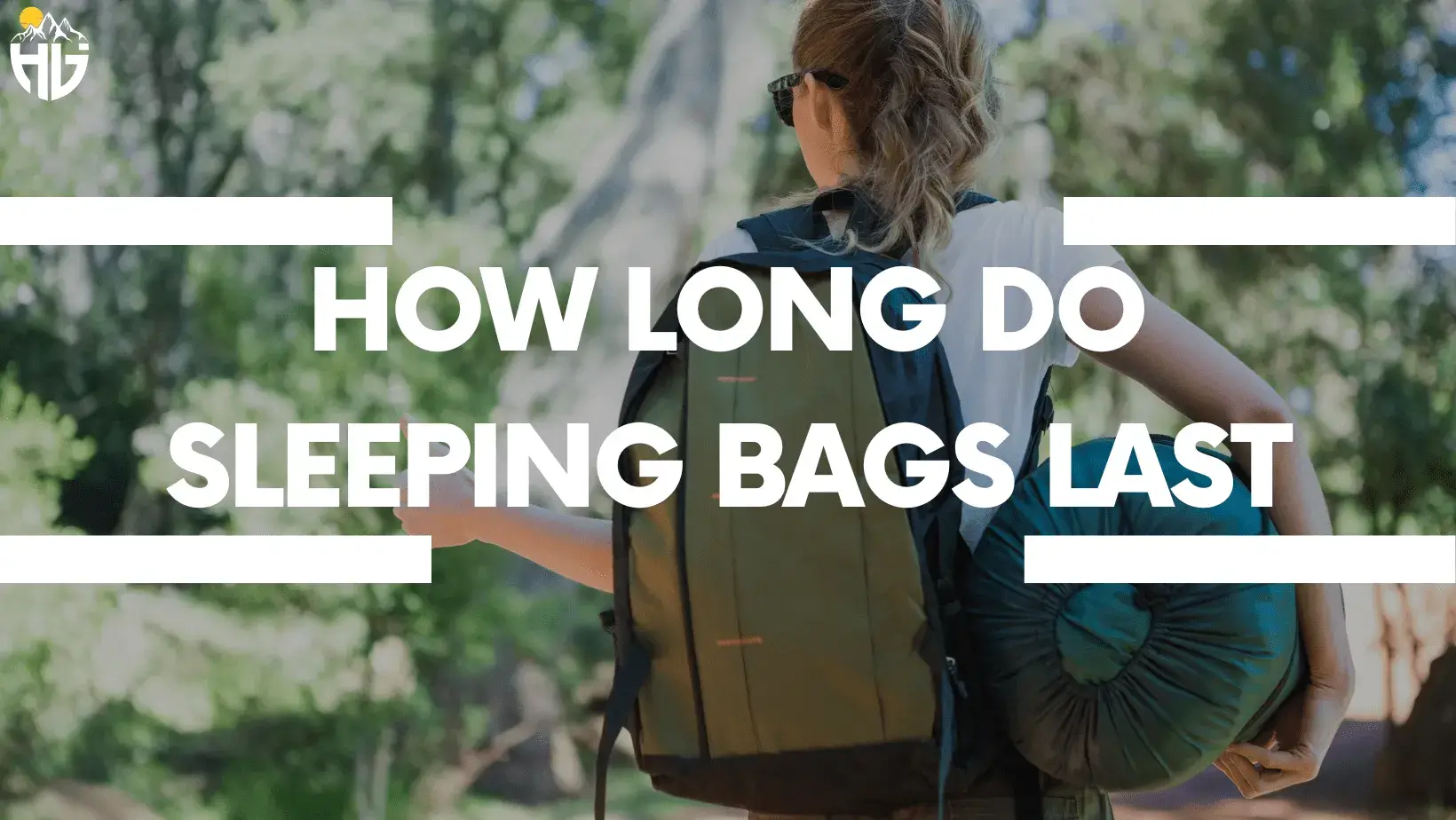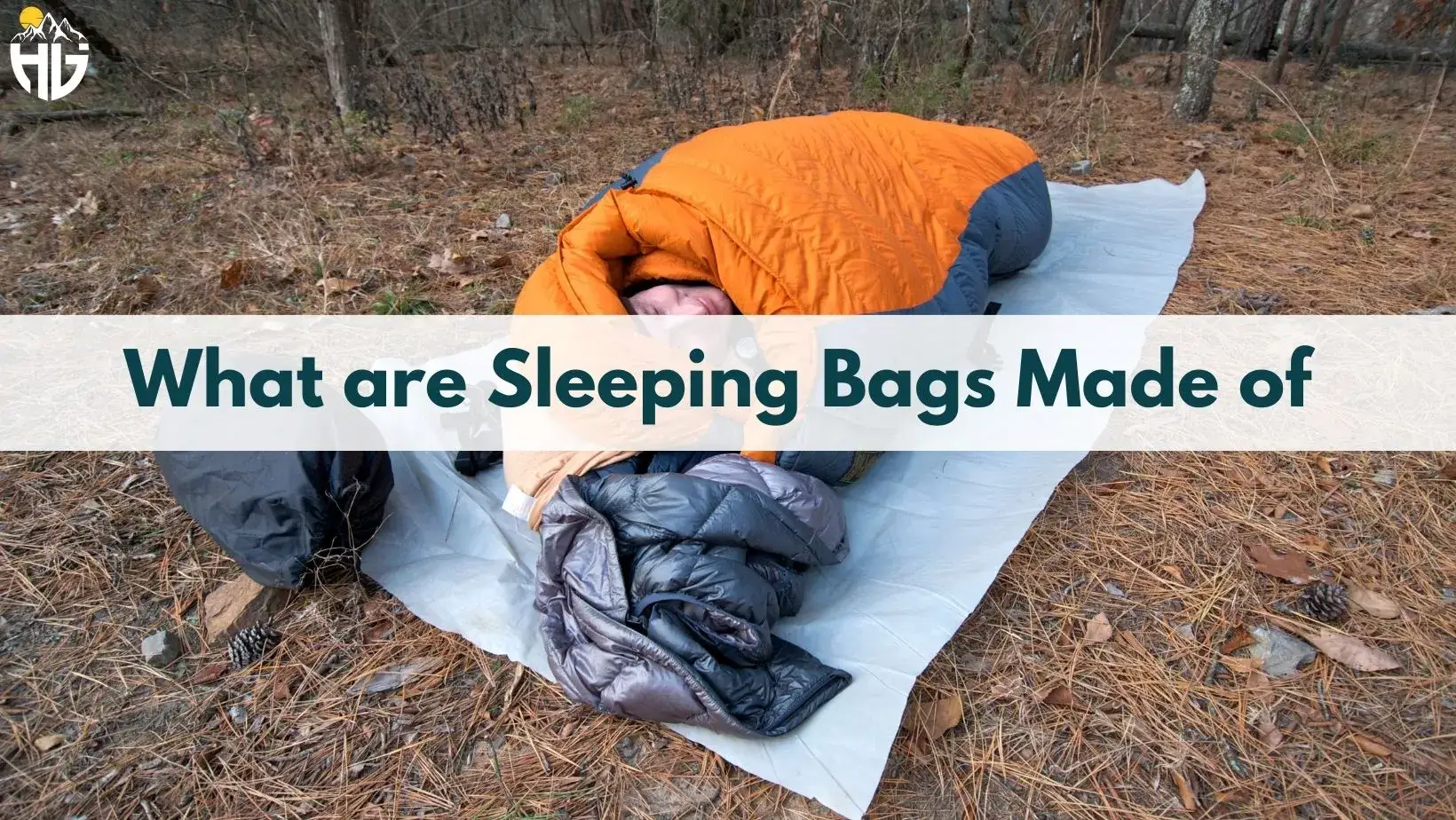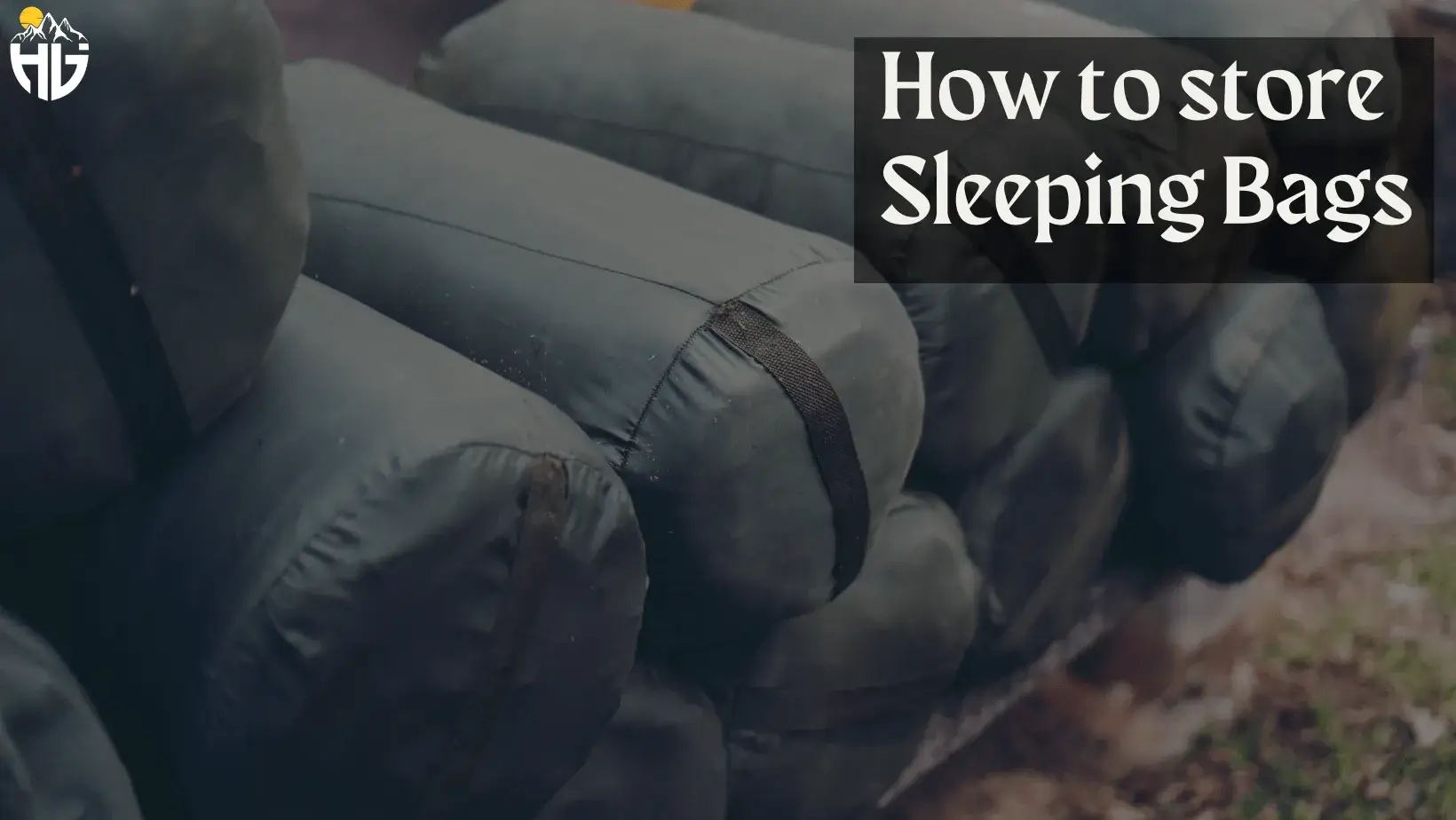How Do Sleeping Bags Keep You Warm

Sleeping bags are essential companions for outdoor adventures, camping trips, to keep you warm. They are designed with different insulations, wool interior, and much more to provide a comfortable and warm sleeping environment.
Their ability to keep you warm lies in their ingenious construction, choice of materials, and the science of heat retention. But have you ever wondered how they manage to keep you warm in varying conditions?
How Do Sleeping Bags Keep You Warm?
The answer lies in the science of insulation and heat retention.
Insulation is the secret ingredient that makes sleeping bags effective at providing warmth. In essence, insulation acts as a barrier between your body and the cold air outside.
It prevents the transfer of heat from your body to the environment and vice versa. To better appreciate how insulation works, think of it as a shield that maintains a microclimate of warmth around you, regardless of the surrounding temperature.
Types of Insulation Materials
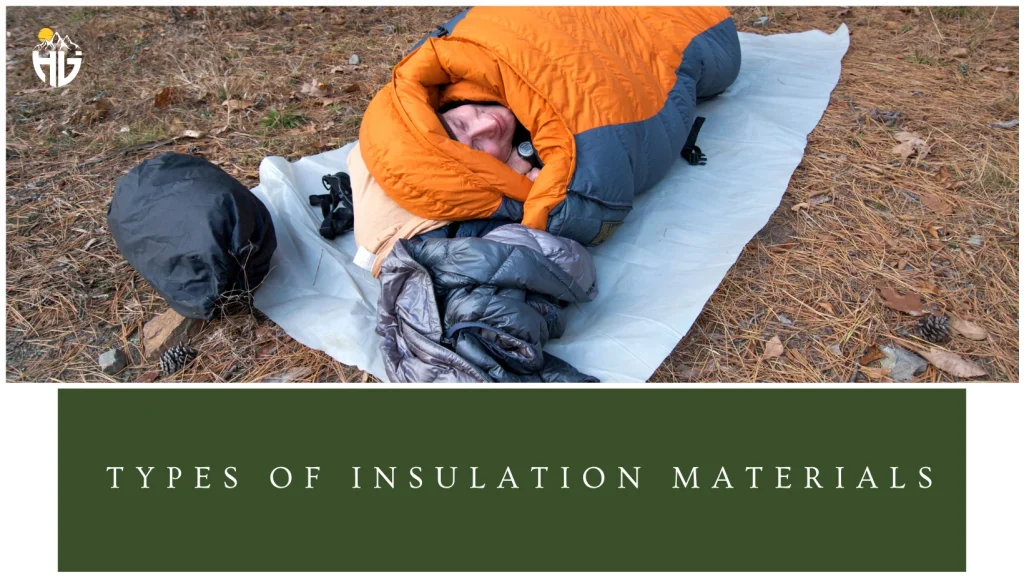
Various materials are used for insulation in sleeping bags, each with its unique properties and advantages.
Down feathers and synthetic fibers are the two main categories of insulation materials.
Down Insulation
It is the soft layer of feathers found beneath the outer feathers of ducks and geese. It is renowned for its exceptional warmth-to-weight ratio and compressibility.
Down traps pockets of air within its clusters, creating natural insulation that effectively retains body heat. However, it’s important to note that down insulation can lose its warmth-retaining capabilities when wet.
Synthetic Insulation
Synthetic fibers, on the other hand, are designed to mimic the insulating properties of down while retaining better performance in damp conditions. These fibers are often made from polyester and are structured to trap air similarly to down clusters.
While synthetic insulation may not be as lightweight as down, it offers the advantage of maintaining its insulation qualities when exposed to moisture.
How Insulation Traps Heat?
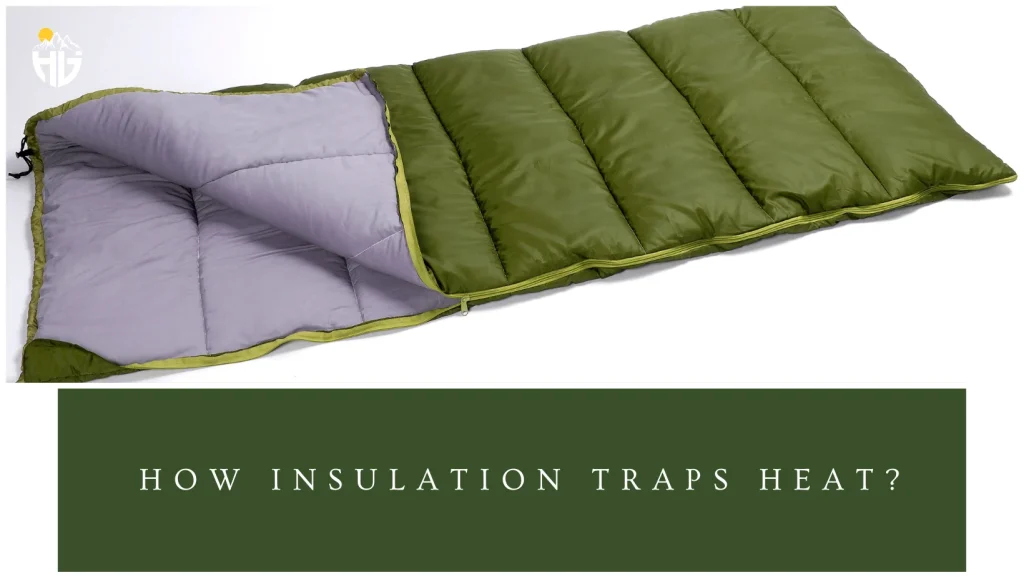
The science behind how insulation traps heat lies in its ability to create dead air spaces. These tiny pockets of air are excellent at reducing heat transfer through conduction.
When your body warms the air trapped within the insulation, the air becomes a barrier that inhibits the passage of cold air from the outside. Essentially, the more dead air spaces your sleeping bag’s insulation can create and maintain, the warmer you’ll remain.
Furthermore, the loft of the insulation plays a crucial role in heat retention. Loft refers to the thickness and fluffiness of the insulation material.
Sleeping bags with higher loft have more dead air spaces, which in turn enhances their heat-trapping capability.
Also Read
How to Zip Together Two Sleeping Bags For Warmth?
Construction and Design

Think of a sleeping bag as a multi-layered shield against the cold. Each layer serves a specific purpose in enhancing insulation and heat retention.
Outer Shell
The outer shell of a sleeping bag is usually made from durable, water-resistant materials. This layer protects the insulation from moisture and abrasions, preventing the loss of insulating properties.
Insulation Layer
This layer is the heart of the sleeping bag’s warmth. Whether it’s down feathers or synthetic fibers, the insulation material traps air to create a barrier between your body and the chilly environment.
Inner Lining
The inner lining is designed for comfort and moisture management. It wicks away sweat and moisture from your body, ensuring that you stay dry and cozy throughout the night.
Insulating Barriers and Draft Tubes
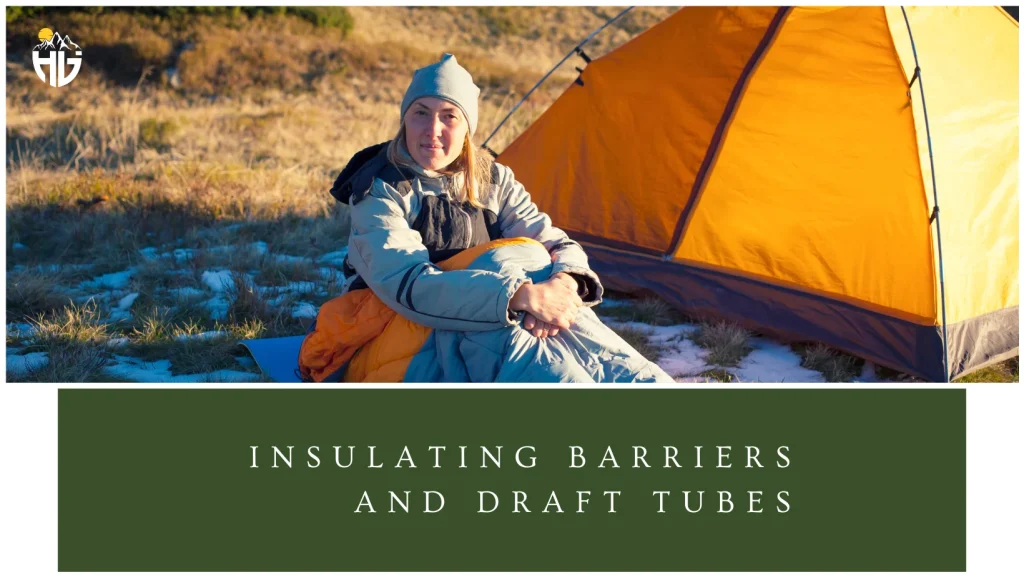
To prevent cold air from sneaking into your sleeping bag, manufacturers incorporate insulating barriers and draft tubes into the design.
Insulating Barriers
These are strips of insulation material strategically placed along the zipper and seams. They prevent heat from escaping through these potential weak points, maintaining a consistent temperature inside the bag.
Draft Tubes
Draft tubes are tubes filled with insulation that run alongside the zipper. They act as a buffer against cold air trying to infiltrate the sleeping bag. Draft tubes play a critical role in minimizing heat loss in mummy-shaped sleeping bags.
Also Read
Sleeping Bag Temperature Ratings

Temperature ratings are your compass in the world of sleeping bags, keeping you warm in different weather conditions.
These ratings typically come in three categories:
Comfort Rating
This indicates the lowest temperature at which a “standard” adult can sleep comfortably. It’s a good reference point for people who tend to get cold easily.
Lower Limit Rating
This rating signifies the lowest temperature at which a “standard” adult male can sleep without excessive heat loss or discomfort.
Extreme Rating
This is the lowest temperature at which a “standard” adult female can survive in the sleeping bag for six hours without risk of hypothermia. It’s best to avoid using a bag at this temperature unless absolutely necessary.
Also Read our Outfit Guide for Different Weather Conditions
How to Choose the Right Bag for Different Climates
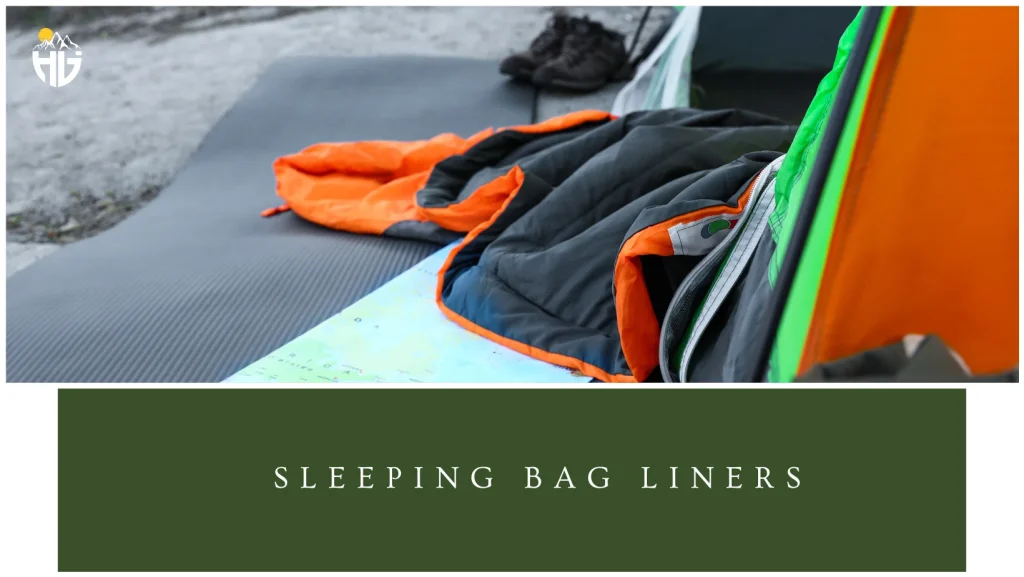
Selecting the right sleeping bag for your adventure involves considering both the temperature rating and the expected weather conditions:
Summer Bags (above 32°F / 0°C)
Sleeping bags are designed for warm climates and are typically lightweight with less insulation.
Also Read
What To Wear Hiking in 40 Degree?
3-Season Bags (20°F to 32°F / -6°C to 0°C)
These versatile bags work well in spring, summer, and fall. They strike a balance between warmth and weight.
Winter Bags (below 20°F / -6°C)
For cold winter expeditions, these bags are heavily insulated to provide essential warmth.
Related Post
What to Wear Hiking in 60 Degree?
Additional Factors for Staying Warm

Utilizing Good Sleeping Pads
A sleeping pad is more than just a cushion for a good night’s sleep; it acts as a critical insulating layer between you and the cold ground.
Ground contact can rapidly drain your body heat, diminishing the effectiveness of even the best sleeping bags.
When choosing a sleeping pad, consider its insulation value, often measured by its “R-value.”
Higher R-values indicate better insulation. Foam, self-inflating, and inflatable pads are common options, each offering varying levels of comfort and insulation. By placing a well-insulated sleeping pad beneath your bag, you create an additional barrier against the cold, ensuring a warmer and more comfortable rest.
Incorporating Hot Water Bottles
Harnessing the power of hot water bottles is a simple yet effective technique to amplify your sleeping bag’s warmth.
Before settling in for the night, fill a heat-resistant water bottle with hot (not boiling) water and place it in your bag.
The bottle radiates gentle warmth, helping you stay cozy in even the coldest conditions. Just remember to secure the bottle’s cap tightly and wrap it in a cloth to prevent direct contact with your skin.
Keeping Dry Clothing Inside the Bag
Wearing dry clothing inside your sleeping bag is crucial for maintaining warmth. Moisture, whether from sweat or damp clothes, can quickly sap body heat. Change into dry layers before entering your sleeping bag to create a dry microclimate that traps heat effectively.
Additionally, if you’re in damp conditions, consider keeping wet clothes outside the bag to prevent any moisture transfer.
Maximizing Skin-to-Skin Contact
While sharing body heat with another person might not always be possible or practical, maximizing skin-to-skin contact within your own clothing layers can make a noticeable difference in staying warm.
By layering snug-fitting base clothing, you create additional dead air spaces that act as insulation. Wearing a hat and keeping your head covered also minimizes heat loss from the top of your body.
Using Sleeping Bag Liners For Added Warmth
Sleeping bag liners are like an extra layer of clothing for your sleeping bag. They not only protect your bag from dirt and sweat but also add an extra level of insulation.
Liners can provide up to 10°F (6°C) of additional warmth, making them a valuable asset in colder conditions. These are designed specifically for added warmth and are ideal for cold weather camping.
These liners are primarily for keeping your sleeping bag clean and can be a great addition during summer to avoid directly sweating on your bag.
Mummy-Shaped vs. Rectangular Sleeping Bags
Sleeping bags come in various shapes, each designed with specific purposes in mind.
Mummy-Shaped Sleeping Bags
These bags are tapered towards the feet and have a contoured hood for your head.
The snug fit minimises the amount of air inside the sleeping bags, reducing the space your body needs to warm up. This design also prevents cold spots and maintains better heat retention.
Rectangular Sleeping Bags
These bags offer more room to move around and are often preferred for camping in warmer conditions.
While they may not be as efficient in retaining heat as mummy-shaped bags, they provide extra comfort and space.
Common Myths Debunked

In the realm of outdoor gear, myths often circulate, perpetuating misconceptions that can impact your camping experience. When it comes to sleeping bags, separating fact from fiction is essential for making informed choices. s.
Myth 1: A Thicker Sleeping Bag is Always Warmer
Reality: While thickness plays a role in insulation, it’s not the sole determinant of a sleeping bag’s warmth. Factors like the type of insulation, loft, and overall design also influence a bag’s ability to retain heat. A well-designed bag with high-quality insulation can be warmer than a thicker bag with inferior materials.
Myth 2: You Don’t Need a Sleeping Pad in Warm Weather
Reality: Even in warm weather, the ground can draw heat from your body, leading to discomfort and potentially disrupting your sleep. Lightweight sleeping bags provides both insulation to keep you warm and a more comfortable sleeping surface.
Myth 3: Sleeping Naked in a Sleeping Bag is the Warmest Option
Reality: While it might seem intuitive, sleeping naked in a sleeping bag isn’t necessarily the warmest choice. Clothing can help trap warm air close to your body, enhancing the insulation provided by the sleeping bag. However, avoid overdressing, as excessive clothing can compress insulation and lead to discomfort.
Myth 4: You Can’t ‘Sweat Out’ Cold in a Sleeping Bag
Reality: Sweating inside a sleeping bag is counterproductive. Moisture can compromise the insulation’s effectiveness and make you feel colder as it evaporates. Dressing appropriately for the temperature and using proper ventilation are more effective ways to stay warm without overheating.
Myth 5: Double-Bagging Increases Warmth
Reality: Doubling up on sleeping bags doesn’t necessarily double the warmth. In fact, two bags compressed together can create cold spots and reduce overall insulation efficiency. Instead, focus on using a single, high-quality bag suitable for the conditions.
Myth 6: You Can ‘Air Out’ a Sleeping Bag by Hanging It
Reality: Hanging a sleeping bag to air it out can actually cause damage, especially if done for an extended period. The weight of the insulation can lead to stretching, and sunlight exposure might degrade materials. Instead, follow the manufacturer’s care instructions for proper maintenance.
Myth 7: Down Sleeping Bags are Useless When Wet
Reality: While down loses insulation properties when wet, modern down sleeping bags often incorporate hydrophobic treatments that make them more resistant to moisture. Additionally, synthetic bags are specifically designed to maintain insulation even when damp. However, it’s still best to keep any sleeping bag as dry as possible.
Myth 8: Can You Really Sleep in a Sleeping Bag Rust?
Reality: No, you cannot sleep in a sleeping bag rust. This is a myth. Sleeping bags are typically made from fabrics such as nylon or polyester, which do not rust. Rust is a chemical reaction that occurs in metals, and sleeping bags are not made from metal materials. Therefore, there is no possibility of a sleeping bag rusting.
Conclusion
Sleeping bags are ingeniously designed to keep you warm in various conditions. By understanding their insulation, construction, and additional warming techniques, you can make the most of your outdoor adventures and cosy nights indoors.
FAQs
How do I choose the right sleeping bag for cold conditions?
Look for a bag with a temperature rating suitable for the coldest conditions you expect to encounter. Consider additional insulation if needed.
Can I use a sleeping bag at home for extra warmth?
Absolutely, sleeping bags can provide extra warmth and comfort indoors during colder months.
What materials are sleeping bags made of?
Sleeping bags are made of various materials, including synthetic fabrics and natural down feathers.
Do sleeping bags lose their warmth over time?
Quality sleeping bags can retain their warmth for a long time with proper care and maintenance.
How can skin-to-skin contact help in staying warm?
Skin-to-skin contact can provide localised warmth, especially when sharing a sleeping bag, but it shouldn’t be relied upon solely for warmth.
What are the most common fillings for sleeping bags?
Common fillings for sleeping bags include down feathers and various synthetic materials like polyester and nylon.
Does skin-to-skin contact keep you warmer in a sleeping bag?
Skin-to-skin contact can provide a temporary boost in warmth by sharing body heat, but it’s not a replacement for proper insulation.
How does a good sleeping pad contribute to staying warm in a sleeping bag?
A good sleeping pad acts as an insulating barrier between your body and the cold ground, preventing heat loss through conduction.
Can using a foam pad enhance the warmth of a sleeping bag?
Yes, using a closed-cell foam pad underneath your sleeping bag adds an extra layer of insulation and minimises heat loss to the ground.
What should I consider when buying a sleeping bag for cold weather camping?
When buying a sleeping bag for cold weather camping, consider its temperature rating, insulation type, and additional features like draft tubes to ensure optimal warmth.

